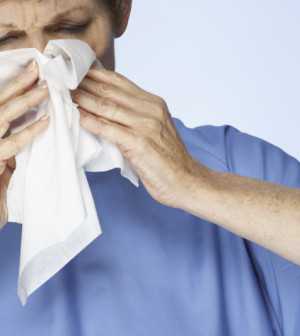- Navigating Your Midlife Crisis: Embracing New Possibilities
- City Raccoons Showing Signs of Domestication
- Mapping the Exposome: Science Broadens Focus to Environmental Disease Triggers
- One Week Less on Social Media Linked to Better Mental Health
- Your Brain Changes in Stages as You Age, Study Finds
- Some Suicide Victims Show No Typical Warning Signs, Study Finds
- ByHeart Formula Faces Lawsuits After Babies Sickened With Botulism
- Switch to Vegan Diet Could Cut Your Greenhouse Gas Emissions in Half
- Regular Bedtime Does Wonders for Blood Pressure
- Dining Alone Could Mean Worse Nutrition for Seniors
New Guidelines for People With Nasal Allergies


For the one in six Americans bothered by nasal allergies, new guidelines have been issued to help doctors diagnose and treat their sniffles and sneezes.
The recommendations from the American Academy of Otolaryngology-Head and Neck Surgery Foundation spell out the do’s and don’ts for treating what’s formally known as “allergic rhinitis,” and often called hay fever.
“What we’re really talking about are allergies that are found all year-round and in every environment, whether urban or rural,” said guideline assistant chair Dr. Sandra Lin, an associate professor in the department of otolaryngology-head and neck surgery at Johns Hopkins School of Medicine in Baltimore.
“This is a really common problem for millions of Americans,” Lin said.
Allergy testing tops the “do” list; sinus imaging is a “don’t” for people with signs of hay fever, and the desensitization process known as immunotherapy can be recommended when other methods fail, the guidelines say.
The recommendations for those ages 2 and up appear in the Feb. 2 issue of Otolaryngology-Head and Neck Surgery.
Nasal inflammation caused by inhaling allergens can create a miserable combination of nasal congestion, itching, drainage and sneezing. There are constant triggers, such as mold, dust and dust mites; occasional triggers, such as dogs or cats; and seasonal concerns, such as pollen, the experts note.
“[Allergic rhinitis] comes in a wide range of symptoms, severities, type and frequency. What we’ve done here is develop recommendations based not only on specialists, but also the point of view of primary care doctors, pediatricians, internal medicine physicians, and patients themselves,” Lin said.
Medication management can help, she said. “We have excellent medications available to us, as opposed to generations before, and most have very low side effects,” Lin said. “It’s just a matter of choosing what is best for an individual patient.”
Key recommendations follow:
- For patients with a stuffy nose, nasal passage discoloration, and/or red and watery eyes, doctors should forgo sinus imaging process in favor of “specific IgE screening.” This involves exposing either skin or blood samples to a series of possible allergen triggers to definitively diagnose allergic rhinitis and its causes.
- “Environmental controls” for dealing with problematic triggers could include use of chemical agents to kill dust mites, installation of air filter systems, using bedding with allergen-barriers, or even saying goodbye to Fido.
- For people whose quality of life is affected by nasal allergies, other treatments include nasal steroid sprays taken alone or in combination with newer antihistamines, which are less likely to cause drowsiness than earlier versions.
- Drugs such as zafirlukast (Accolate) and montelukast (Singulair) — known as oral leukotriene receptor antagonists — are not advised as a first-line treatment for hay fever.
- Immunotherapy — either desensitization shots or under-the-tongue pills — are an option when medication and environmental controls don’t work well.
- Nasal surgery called turbinate reduction should be offered only when medical management fails.
- Acupuncture can be suggested to patients who want to avoid medications. Herbal supplements were not addressed.
Immunotherapy, which involves placing patients on a carefully controlled and slowly increasing regimen of allergen exposure, may be the treatment approach of the future. The natural immune response that ensues can dramatically reduce or even eliminate allergy symptoms in some people, Lin said.
“The degree of response varies, but I have patients who were never able to enter a house with a cat before immunotherapy, and now they can be there for a few hours,” said Lin. “And with the approval of [under-the-tongue] tablets in April, we now have an easier way of delivery that will be more comfortable for many patients, particularly children. That’s exciting.”
Dr. William Reisacher of New York City is also enthusiastic about immunotherapy.
“I think we’ve really maxed out on new meds,” said Reisacher, an associate professor of otolaryngology at New York Presbyterian/Weill Cornell Medical College.
“But what’s going to happen with immunotherapy in the next five to 10 years is going to be amazing,” Reisacher added. “We’re understanding more and more about inflammation on the cellular level, and we have powerful new desensitization tools coming down the pike and many more ways to deliver it, with skin patches, drops, tablets and even toothpaste.”
Immunotherapy now, he said, “is sort of a last resort, more or less. But it won’t be that way in the very near future.”
More information
There’s more on nasal allergies at the American Academy of Otolaryngology-Head and Neck Surgery.
Source: HealthDay
Copyright © 2025 HealthDay. All rights reserved.










